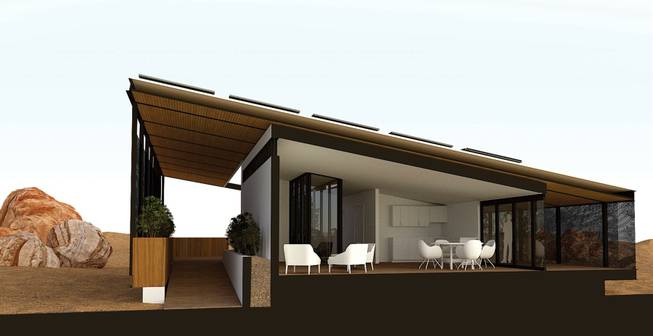
An artist’s rendering depicts a home being designed by the UNLV Solar Decathlon team will be “the last home you’ll ever buy.”
Sunday, Feb. 28, 2016 | 2 a.m.
Instead of being sent to a nursing home, what if the elderly could live the remainder of their lives in the comfort and security of their own homes?
That’s the question a group of UNLV students are trying to answer in time for next year’s Solar Decathlon, staged by the U.S. Department of Energy. The contest tasks teams from universities around the world to design, build and market energy-efficient houses. UNLV was picked last month to participate for a second time.
In 2013, the UNLV team came in second with DesertSol, an ultra-efficient house that’s now on exhibit at Springs Preserve. The theme of the 2013 competition was vacation homes.
While the theme of next year’s competition is under wraps for now, the UNLV team says they already know what direction they want to go.
“Instead of marketing the first home you’ll ever buy, we want to market the last home you’ll ever buy,” said David James, a UNLV engineering professor and adviser to the team.
The concept is called aging in place. Traditional approaches to end-of-life care for seniors include group homes and assisted-living facilities, but both come with downsides. Elderly people in nursing homes often suffer a loss of independence, can be cut off from family and are separated from homes many have lived in for years.
At the same time, families often worry about elderly relatives living alone because of health risks. If Grandma were to fall, nobody would be around to help her.
But what if homes were designed with old age in mind?
James’ own experience helping his aging parents inspired him to focus on the issue from an engineering perspective. Census data predict a 70 percent increase in the senior population by 2020, a phenomenon known as the Gray Tsunami. Millions of baby boomers will become elderly and could put a strain on the health care system.
The UNLV team hopes to integrate telemedicine technology into a home design that will enable seniors to remain at home while dramatically reducing the risk of accidents. That means modifying homes to include motion sensors, webcams and railings, and generally making them easier to navigate.
“What we’re trying to do is combine all that with a sustainable home,” James said.
To better understand the risks the aging population faces, the team is partnering with UNLV’s health sciences department to design the home.
But they have a long way to go.
The competition is about a year and a half away, and the team has to raise close to $1 million just to fund construction and shipping costs. The students will build the house in Las Vegas, then ship it to the competition site, which hasn’t been announced.
Judges score each home on such factors as market appeal, comfort and affordability. Teams are free to use innovative architecture and construction materials, but they must stick with off-the-shelf appliances and utilities.
The 2013 UNLV team brought together about 60 students from multiple disciplines to design, build and market the home. They beat out every other American team but fell short of the top prize, which was captured by a team from Austria.
Next year, they’ll compete for $2 million in prize money.

Join the Discussion:
Check this out for a full explanation of our conversion to the LiveFyre commenting system and instructions on how to sign up for an account.
Full comments policy